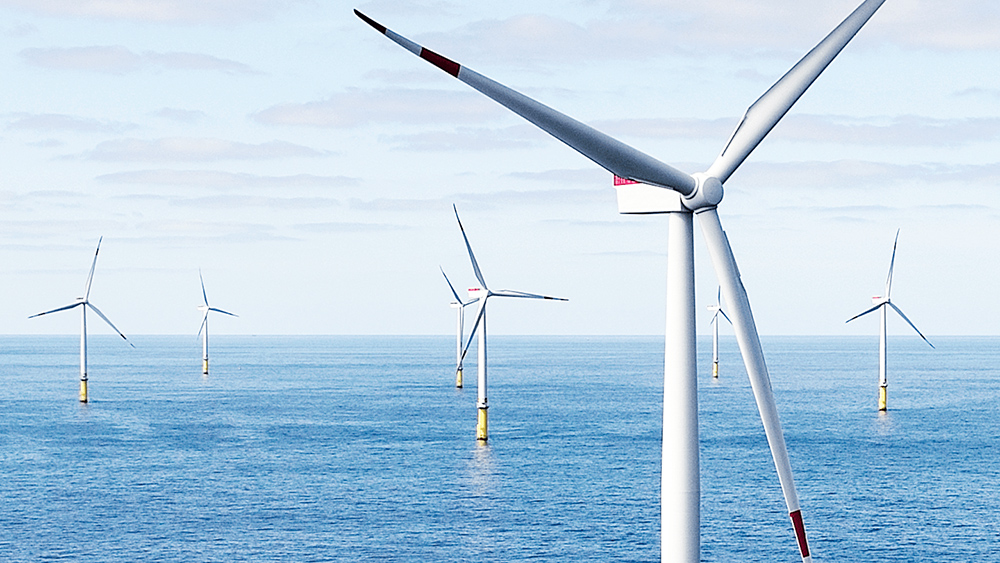By Sarah Fertsch
Staff Writer
On Tuesday, May 31, the PR Council of Atlantic City hosted representatives from Orsted, offshore wind contractor for the state of New Jersey. The meeting, held at Resorts’ Atlantic Ballroom in Atlantic City, centered on how offshore wind will affect the economy in Atlantic and Cape May counties.
Tom Suthard, Orsted’s New Jersey stakeholder relations manager, presented information on upcoming projects, innovation, and updates relating to Ocean Wind 1 and Ocean Wind 2, the wind farms being built 15 miles off the coast of Atlantic and Cape May counties.
Since former Gov. Chris Christie’s initial wind proposal in 2010, and Gov. Phil Murphy’s Offshore Wind Strategic Plan in 2020, Orsted has been busy establishing itself as an industry leader across the United States and Europe. The Danish company has built nine offshore wind farms in several states including New York, Maryland, Delaware and Virginia, and believes that New Jersey offers promising opportunities for sustainable energy.
In the next two years, Orsted plans to construct Ocean Wind 1, which will power up to 500,000 homes and support thousands of jobs.
The company will stage its projects out of the Port of Paulsboro and the Wind Port at Salem, which will manufacture and prep ships to carry wind turbines across the ocean to the wind farm.
After Ocean Wind 1 is operational, Orsted will begin work on Ocean Wind 2, set slightly south of its sister farm.
The Wind Port is made possible through millions in government infrastructure spending. The 2022 New Jersey budget includes $200 million for the port in addition to $13 million from the BPU and $44 million from the state Department of Transportation for dredging. An additional $9 million comes from the U.S. Department of Transportation for the Salem Marine Terminal.
“We are basically building an entire industry from the sea floor up,” said Suthard. “Phase 1 will employ about 260 New Jersey painters, welders and workers, and when Phase 2 occurs, we will employ over 500 people, with wind technicians earning approximately $100,000 per year.”
By September of 2022, Atlantic Cape Community College expects to open a Wind Training Safety Center at the Worthington Campus in Atlantic City and at Gardner’s Basin. The center will meet industry safety standards for first aid, fire awareness, working at heights, and sea survival. The program is expected to attract students from all over the country and train 1,800 in its first year.
The Atlantic Cape initiative is funded by a $3 million challenge grant from the New Jersey Economic Development Authority. A similar NJEDA grant worth nearly $1 million was approved for Rowan College of South Jersey to create an offshore wind technician training program. Also, Orsted will open offices in the city as well, which should be ready this summer.
When it comes to financing the construction projects, Orsted has committed to paying for all projects with some major investments from PSEG and General Electric. The Danish company says it’s dedicated to the well-being of the Garden State, protecting lands, waters and livelihoods for the future.
Liz Thomas, public relations account manager for Thomas/Boyd Communications, representing Orsted in New Jersey, reports that the community has expressed two main concerns: appearance, to the extent that the turbines block the horizon on the ocean, and disruptions to the fishing industry.
Addressing the first issue, Thomas said that because the wind farms will be located 15 miles offshore, the massive structures will not disrupt the beauty of the coastline.
In regards to marine ecosystems and fishing vessels, Thomas said that neither will be negatively impacted by the wind farms. Orsted has funded multiple research inquiries and no data indicates hardship on sea creatures. In fact, the U.S. Bureau of Offshore Management, which oversees locations of offshore industrial work, has deemed the waters off South Jersey suitable for Orsted’s projects, in large part because that section of the Atlantic Ocean is considered a “fish desert.”
To further dispel negative perceptions, Orsted has donated $12 million to the New Jersey Wildlife Fund. Also, the company plans to deploy bubble curtains, which break up the noise pollution in the waters, protecting animals like the Atlantic white whale.
“It will be a transition, but it will be similar to casino gaming,” said Suthard. “It will benefit our economy and help Atlantic City grow.”
Atlantic County Commissioner Caren Fitzpatrick spoke in favor of the new projects.
“I am a strong advocate and the loudest voice for sustainable, renewable energy,” Fitzpatrick said. “This is a very big deal for us and it has a huge economic impact.”
Ocean Wind 1 has been a source of controversy in Ocean City among those who are uncomfortable with the environmental impact of the proposed power cable route, which has not yet been approved by the Board of Public Utilities. According to published reports, the underground cable would come from Bay Avenue, underRoosevelt Boulevard, under Peck’s Bay, Roosevelt again, to North Shore Road in Upper Township, to the BL England Power Plant.
For more information on Ocean Wind 1 and Ocean Wind 2, visit the websites oceanwind.com and oceanwindtwo.com.
Ocean Wind 1 has been a source of controversy in Ocean City among those who are uncomfortable with the environmental impact of the proposed power cable route which has not yet been approved by the Board of Public Utilities. According to published reports, the underground cable would come from Bay Avenue, onto Roosevelt Boulevard, under Peck’s Bay, Roosevelt again, to North Shore Road in Upper Township, to the BL England Power Plant.
Sarah Fertsch is a writer and artist who has recently moved back to South Jersey. She loves satire, a good cup of coffee, and exploring new places.






